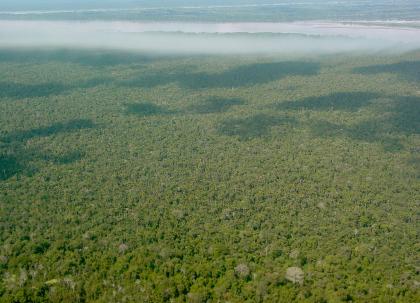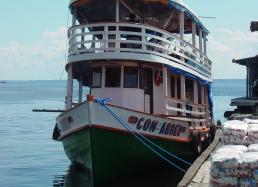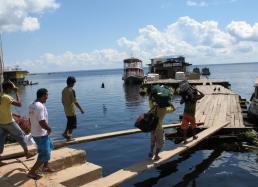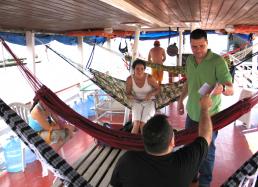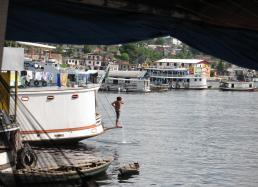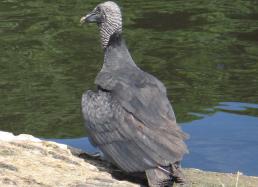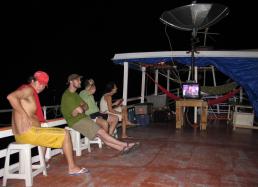Blog #2: Sittin' on the Dock at Tefé
We woke up early this morning and loaded our gear into a minibus that took us to the Manaus airport, where we checked in for our indirect flight to Tefé. Our flight took us west past Tefé to Tabatinga, the Brazilian border town with Leticia, Colombia, where we landed briefly to drop off and pick up passengers before taking off again for Tefé.
For the entire flight, our eyes were glued to the window, where huge winding rivers and the green carpet of the Amazonian wilderness stretched out below us (see above photo.) Every time I fly over the Amazon, it’s hard to fathom that we’re flying over the world’s largest and most diverse tropical forest wilderness.
We eventually arrived in Tefé and were waiting outside for only a few minutes when we managed to spot our first tropical birds—a couple of Social Flycatchers (Myiozetetes similis)—in some shrubs next to the airport.
Eager to get started, Alex called his students by cell phone and arranged for a truck to pick up our gear, then we hopped into a taxi to follow the truck down to the waterfront, where our riverboat home—the Commandante Abreu—awaited us (see Photo #1 below.) This two-story vessel is loaded with all of the amenities for sleeping, eating, working, and bathing during our four-week expedition up the Rio Japurá and its tributaries (take a tour of the boat in my “Video Journal #5: Riverboat Living.”)
At the boat, it was great to meet up with Alex’s students, Elinete Rodrigues and Maya S. Faccio, as well as the Goeldi Museum’s bird specimen preparator, Nilton Santa Brigida, with whom we’d worked on an earlier expedition in 2007. Also on board were Manoel Santa Brigida (Nilton’s father and retired Goeldi specimen preparator) and ornithologist Dr. Marcos Persio. (Check out the "Meet the Team" section of our website for photos and bios of these folks.)
After carrying our gear to the boat (see Photo #2 below), we set up our hammocks (see Photo #3 below) and waited for the remaining food items and supplies that would be delivered. Elinete, Maya, Marcos, and the Santa Brigidas did an amazing job of stocking the boat for our trip north!
We spent several hours waiting on deck and took one foray into the nearby market to pick up the last few remaining supplies. I always find Amazonian markets to be fascinating places, especially with regard to the fishes that one can see, including peacock bass (locally called Tucunaré) and Tambaqui (a large, fruit-eating Piranha relative).
After our foray into the market, we returned to the boat and waited yet again for several more hours. Although waiting can be boring at times, Amazonian ports are bustling places, with boats driving all over the place and loudspeakers blasting announcements. To get a taste of what an Amazonian port is like, see Photo #4 below, and check out my “Video Journal #1: Our Journey Begins.”)
If you’re lucky, while at port you can spot some local bird species, including the usual trash-consuming Black Vultures (Coragyps atratus), which also live in the southern U.S. Ironically, they can be quite a rarity as far north as Chicago, so John and I even welcomed seeing them (see Photo #5 below.) Although these ports are often full of boats and people, one of the cool critters that can be spotted is the Pink River Dolphin (Inia geoffrensis), so much of our sitting time was spent watching for these amazing mammals to surface near the docks.
Finally dusk came around, and with all of our supplies now on board, we began our overnight journey across the Amazon River (Rio Solimões). Given that it was dark, there wasn’t much to see, other than the incredibly starry sky over our heads.
To entertain ourselves, we decided to take advantage of the old satellite dish on the boat’s roof (see Photo #6) to see if we could pick up a telenovela (the Brazilian equivalent of a soap opera) or a soccer game on the television. We watched for a while, although reception wasn’t fantastic—kind of like watching TV using the old-fashioned rabbit ears, with the images sometimes cycling up or down the screen.
Eventually it was time for bed and we all hopped into our hammocks for a good night’s sleep....
More soon,
Jason
